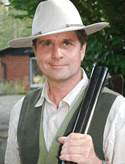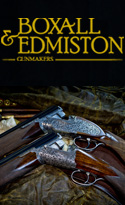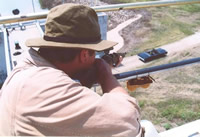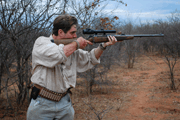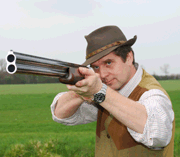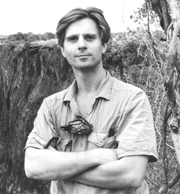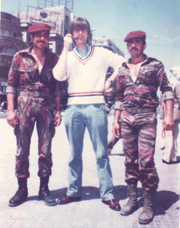Truck Hunting
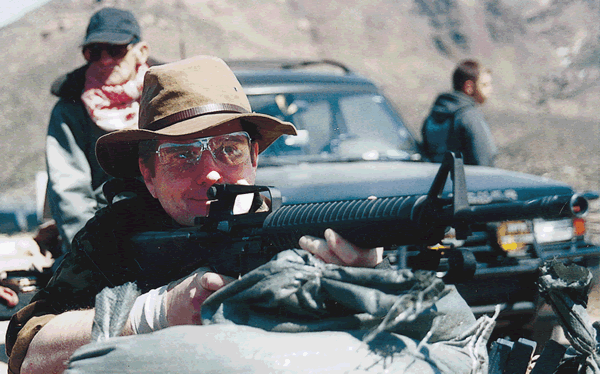
Truck hunting is not my normal thing, but I have a few arguably relevant qualifications. As well as the usual BASC member’s profile (game, clays and stalking), I have been an army officer, knocked around Africa a bit and been shot at and bombed (more is the pity) in Lebanon and Afghanistan. I spent a couple of years training people to shoot police weapons. Recently, I have been working as a ballistic consultant and ‘sharpshooter’ (their term not mine) for the Discovery Channel ‘Unsolved History’ series.
This has led to some interesting work, including re-enactments of the assassinations of JFK and Robert Kennedy. The former proving the Oswald could have done it with a 6.5 Carcano, the latter indicating that RFK’s death was just as suspicious as his brother’s. Then there was the alleged attempt on Abraham Lincoln’s life outside Washington in 1864. Could you hit a target consistently at half a mile with a muzzle loader? Yes, if it’s a .451 Whitworth.
The most unusual brief to date is the subject of this article. What would it take to stop a truck intent on blowing you and all your friends to kingdom come? In 1983, the terrorist organisation, Hezbollah, bombed the Marine Corps barracks in Lebanon killing 241. There was much speculation as to how the guards reacted on the day. Unsolved History decided to shed a little light.
“Michael,” the producer asked, “if we provide a radio controlled vehicle, what do you need to shoot it?” “Well, a .45 1911 Colt pistol and an M16 rifle to begin with – the Marines in Lebanon were issued with them. A 1/2” machine gun and an anti-tank weapon would be useful too.” After some trans-Atlantic negotiation, we settled for an M60 7.62 machine gun. The mission accepted. The pressure was on. I was off to Hollywood again.
There were some difficulties in finding the right kit – LA has lots of theatrical armourers, but guns – though they may be real – are not usually required to be used accurately with live ammunition. Finding a suitable range for testing – before a job like this I always insist on day of testing – was also problematic. Our props master, David Aaron, a veteran of dozens of feature productions, eventually found a venue in the hills outside town. A private shooting club, it was made somewhat more interesting by the fake western town constructed within its grounds – western shooting is a big deal in the states.
Shooting the .45 pistol was no great revelation. Ours was a standard military model with iron sights firing ball ammunition. It shot well provided one gripped it properly and maintained a good sight picture. The first .223 rifle to be tested was not an M16 but a shorter M4 equipped with an electronic red dot sight (the director thought it looked more interesting). It was a selective fire version, but the wretched thing could not be sighted in. I am not fond of gimmicks. It was soon replaced by a traditional iron-sighted M16 as originally intended. This was fabulously accurate and very soft in recoil in semi-auto mode.
Full auto, however, even controlled burst, the M16 was not especially effective (but fun with a more or less unlimited supply of ammunition). The M60 was interesting too. Automatic only, it has a surprisingly slow rate of fire (nevertheless, controlled burst is still the only way to be effective). Gremlins struck. After all possible adjustments, our M60 continued to shoot about two feet to the left at 50 yards. There was no replacement. One just had to note the error and aim off. It would make the firing trials at a moving target significantly harder. No choice but to live with it and make in work anyway – a professional challenge.
The main experiment took place at a ‘movie ranch’ outside Hollywood. On a recce a few days before filming, I was intrigued to see the tank – something akin to a large swimming pool – in which a model of Titanic had been filmed. It was in the middle of scrubland. The place looked much less surreal on the day of filming with several camera crews, lighting, catering and make-up trucks, police and fire department people, an ex-Marine consultant, and various actors including our splendidly made-up, heavily bearded, ‘terrorist’.
We had to water down the parched earth to keep the bureaucrats happy. Meanwhile, I took one look at the outrageously expensive radio controlled vehicle and decided that we had better armour plate the front in case I got lucky with an early shot from the .45 or M16 and wiped out the radio control and with it the rest of the day. The plot was simple. We would test the pistol first, opening fire at 200 yards at the moving vehicle and stopping at 50. The target for this phase would be a silhouette on an outrigger (we did not want to shoot the vehicle up too early). Amazingly, I managed two central hits as it hit the 100 yard mark.
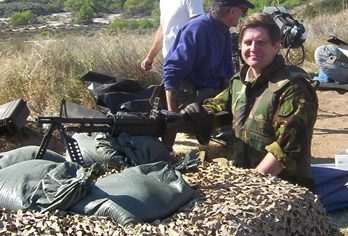 The second run would involve precise fire from the M16 at another silhouette target positioned in the driver’s seat. This would necessitate shooting through the windscreen. This was most interesting. Results were better than expected. There was no need to aim off as the vehicle was coming directly towards me. Only semi-auto mode was employed, the test firing sessions proving that this was by far the most effective way to use this weapon.
The second run would involve precise fire from the M16 at another silhouette target positioned in the driver’s seat. This would necessitate shooting through the windscreen. This was most interesting. Results were better than expected. There was no need to aim off as the vehicle was coming directly towards me. Only semi-auto mode was employed, the test firing sessions proving that this was by far the most effective way to use this weapon.
The run with the M60 was more complex. Could we actually stop the vehicle this time? The ‘armour’ - ¼” steel plate - was removed. David prepared a 200 round (!) belt for the weapon. I began programming my mind for the way off-target zero. We would commence firing at 300 yards and keep going. Everyone retreated, my No 2 and I wore body armour and helmets, we would fire from behind sandbags to help protect from ricochets. A walkie-talkie crackled, the top cover of the M60 was raised, we loaded and gave a thumb’s up and waited for the target vehicle to appear (it was controlled by a team with a TV monitor well to the rear).
Target acquired! I started to strafe the driver’s compartment. Rat a tat tat. It kept coming. I shot out one of the front tyres. It kept coming. I started to pour fire into the engine area. It still kept coming. Damn. 70….60…50 metres. I went from controlled burst to sustained full auto (the term for this is Final Protective Fire – not something that you would ever want to experience in any place other than a film set). The vehicle was taking a vast number of hits. Eventually, it came to a halt almost bumping into our position and bleeding oil everywhere. It was far too close for comfort. Had there been a bomb we would have been dust.
Conclusions? Hollywood is unbelievably PC. Meanwhile, if there are mad, well-motivated, people intent on doing way with you, get the largest weapon you can. Twin mounted 50s are the absolute minimum for the Aston before engaging White Van Man. Take my word for it. A .30 calibre or two is not big enough. The problem is the momentum of a large moving object – that requires heavy medicine, concrete barriers or a great deal of diplomacy.
It was interesting on inspecting the remains of our vehicle to see that the .223 rounds had not penetrated all the way through, the 7.62/.308 ball did.


